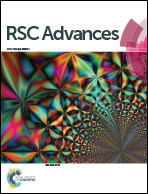Facile and single-step route towards ZnO@C core–shell nanoparticles as an oxygen vacancy induced visible light active photocatalyst using the thermal decomposition of Zn(an)2(NO3)2†
Abstract
Zinc oxide–carbon (ZnO@C) core–shell nanoparticles were synthesized using a facile and single-step method, which involved the thermal degradation of a zinc aniline nitrate complex in methanol. The formation of ZnO and carbon was observed during the early stages of synthesis (>200 °C), whereas a further increase in the temperature determines the level of the carbon coating. Transmission electron microscopy confirmed that the ZnO@C nanoparticles obtained at 600 °C were ∼100 nm in size with a uniform 5–20 nm thick carbon coating. The nano-coating of carbon on ZnO along with the presence of oxygen vacancies promoted its photocatalytic activity under visible light with higher efficiency for the photodegradation of rhodamine B than bare ZnO. The two probable pathways for the visible activity and the enhanced photodegradation capacity of ZnO@C core–shell nanoparticles are also discussed. The synthesized ZnO@C core–shell nanoparticles exhibited very good stability and recyclability, highlighting their potential use as an efficient visible light driven photocatalyst for pollutant degradation.


 Please wait while we load your content...
Please wait while we load your content...